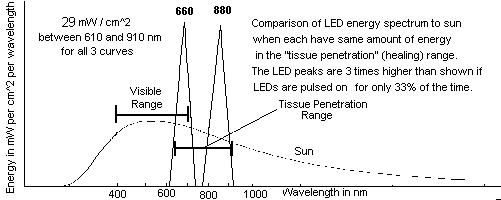How can light accelerate healing?
Although having super powers would be fun, it is not possible at the moment. However, accelerating healing through light is possible and is backed up with years of research from the likes of NASA, the Military, and Research Institutions.
Researchers working with NASA have found that light therapy using near-infrared LEDs operates by activating color-sensitive chemicals in body tissues, stimulating the process in a cell’s mitochondria. Light wavelengths from 680 nm to 880 nm have been found to travel through skin and muscle tissue, to prompt tissue and deep wound healing. [3]
There have also been clinical trials taking place in hospitals in the US and elsewhere. Results indicate that light therapy accelerates cell growth by 150 to 200% compared to non-treated cells. [1]
Building upon NASA's work, the University of Chicago discovered that the average wavelength of cell tissue in the human body ranged between 600 nanometers and 720 nm, with 660 being the mid-point. This means 660 nm should work better than any other single frequency, as it is closer to the resonant frequency of cell tissue. Apparently 660 nm also absorbs better in hemoglobin. [2]
This is why over the years researcher have migrated to infrared, red, and eventually the 660 nanometer wavelength, as it turned out to be the most efficient wavelength to regenerate tissue. In real terms this means an injury that would usually take 10 days to heal could potentially recover in just a few days. [2]
660nm red light is claimed to penetrate about 25 mm into the skin, making it useful for healing skin wounds and infections. While near-infrared goes up to 75 mm, and could be used to increase blood flow and release nitric oxide to soothe and heal sore muscles and joints[1]

The depth that the light needs to penetrate depends on whether you are tackling surface tissue wounds or deep muscle.
What is really interesting is that sunlight naturally has the 660nm light in it. Take a look at the distribution of wavelengths in sunlight from the graph below:
Image from http://solarjourneyusa.com/sunlight.php
Basically this means just going outside and getting some sun can help heal your wounds quicker.
However, the below graph does show that the 660nm wavelength LED would produce move energy than the sun. Hence the reason why creating a healing device is still a good idea.

Graph from http://heelspurs.com/led.html
This extract from Scott Roberts heelspurs.com explains the importance or light and sunlight.
-
In hindsight, we can say "people have always known Sunlight is good for you". It seems intuitively clear to most people that Sunlight helps sick people and enables people to be more active. We know why from a chemical and biological viewpoint. Injured cells need the extra ATP to repair themselves. Healthy cells may generate extra ATP from the red and near infrared of sunlight to enable more activity in the daytime. If the ATP is not used (as occurs when resting in bright sunlight) it causes an increase in available glucose for which causes a slight "glucose high" that causes relaxation and sleepiness we all feel after 30 minutes in the sun. BTW, we know UV creates vitamin D that prevents colon, prostate, and breast cancer, greatly improves the immune system, bone strength, and reduces the incidence of osteoarthritis, having the potential to save 50,000 lives a year if people would get more Sun and wear less sunscreen. By comparison, skin cancer causes less than 10,000 deaths in the U.S. each year, only some of which are caused by too much Sun.
-
Scott also goes into great detail of how our bodies evolved to 'Like' light, and deeply explains the biological aspects (Warning you may need a degree in Biology or related field to fully understand). [8]
Applications
I have heard of this technology being used to: Heal Injuries Faster [3], Reduce Acne [7], An Aid to Carpal Tunnel, Stimulate the Release of ATP, Dementia [5], Help Knee Injuries, Joint, Shoulder...
Read more » James Cannan
James Cannan